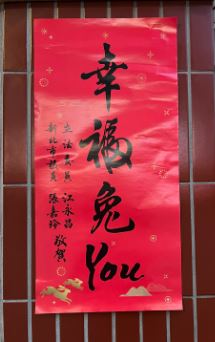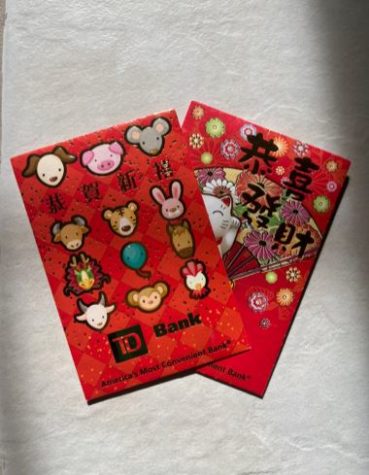Celebrating Lunar New Year

Photo courtesy of Charlotte Rhodes. Lunar New Year was celebrated on Jan. 22, 2023. It’s not only a day of commemoration of the new year but a celebration of the culture and the people coming together to celebrate it.
Unlike the Gregorian calendar most of the world uses, China and other Asian countries around the world use the Lunisolar calendar. This determines that their new year’s celebration for this year was on Jan. 22. Each year the date of the new year but it always takes place between Jan. 21 and Feb. 20. The event is referred to as Chinese New Year, Lunar New Year, or Spring Festival. Associate principal Ann Wong stated, “I have celebrated Lunar New Year since I was little and I continue that tradition with my family now.” Chinese New Year and Spring Festival are specific to what China and Taiwan celebrate, while Lunar New Year is the more general term for the celebrations specific to what Japan, South Korea, Mongolia, Vietnam, and other Asian countries celebrate. Junior Abbey Chun mentioned, “I celebrate Lunar New Year at home with my family and every year we usually eat Tteokguk, which is big for Korean New Year.” Another student, Junior Connor Kim said, “I have friends that celebrate Lunar New Year and they enjoy celebrating the holiday”.

Zodiac Animals:
This year lands on the fourth zodiac animal on the Lunisolar Calendar; the rabbit. Though it’s the Year of the Rabbit, in Vietnamese culture, it’s the Year of the Cat. The most common belief for this change in zodiac animal is the word used for rabbit (mẹo) and the word for cat (con mèo) sound alike; the traits of the rabbit are attributed to the cat. It is believed that people born in the Year of the Rabbit are expected to have substantial changes in their career, relationships, and health this year.
An ancient Chinese legend states that the Jade Emperor, the ruler of Heaven, wanted the animals to have a race and the first 12 who win would become the 12 zodiacs of the year. The cat was known for sleeping in late and being grumpy when woken up, so the rat was supposed to wake the cat up on time; they were best friends. On the day of the race, most of the animals had arrived early to get on the calendar except the cat. The cat woke up late but still made it to the race arriving in thirteenth place. After finding out who got thirteenth place, the cat chased the rat all around the palace. This is why cats chase rats in the present times. The final 12 zodiac animals are rat, ox, tiger, rabbit, dragon, snake, horse, goat, monkey, rooster, dog and pig.
Traditions:
Throughout the centuries, the color red has been used for the robes for high officials, traditional wedding dresses, envelopes for gifts of money, and the walls that surround the Forbidden City in China are red to keep all who are inside safe. Red is associated with Chinese New Year because it is deemed as the color of celebration, fertility, prosperity, and repelling evil in Chinese symbolism. The red envelopes, known as hóngbāo (红包) in Chinese, or lucky money contain money and are given as gifts from adults to children to symbolize good luck in the coming year. It is disrespectful to open the red envelope in front of the donor, one must open it in private or when they arrive home. Chun said, “The red envelopes are the most popular Lunar New Year tradition along with the food.”

Spring Festival in China, is a 15-day celebration marked by many traditions. Such as offering sacrifices to ancestors, watching lion and dragon dances, eating dinner with family on New Year’s Eve, gifting red envelopes, and setting off firecrackers. Decorating the house with Chinese couplets and lanterns is another tradition many take part in. On New Year’s Day, there can be no sweeping or cleaning of the house so that no good luck is swept away. Many households clean on New Year’s Eve making sure the house is clean and spotless to get rid of the past year’s bad luck and to make room for the new luck. Wong said, “My family would always clean the house making sure it was immaculate.” It’s a time where families gather together, create new memories, and bond over the joyous filled traditions that ring in the new year. Also, people go to the temples to pray to the gods and goddesses.
Cuisine:
Food has a big involvement with the celebrations of Lunar New Year. On New Year’s Eve or Day people eat dumplings to represent fortune in the new year, spring rolls to represent wealth in the new year, fish to increase prosperity in the new year, noodles to represent longevity and prosperity in the new year, and sweet rice balls, known as tāngyuán (汤圆) in Chinese, to represent harmony and family union in the new year. Wong stated, “My parents would make all of these wonderful Chinese dishes on New Year’s Eve and on New Year’s Day, my family would all gather together. The celebration would be wonderful and it was always about the food”. Tāngyuán is made for the lantern festival, which falls on the fifteenth day of the first lunar month; marking the end of the Spring Festival celebrations. Traditionally, the food is made from scratch and it may take all day to make.
The many traditions that take place, food dishes made, and the various zodiac animals make Lunar New Year, Chinese New Year, and the Spring Festival what they truly are, an occasion that brings families together. These days of celebration are not just a commemoration of the new year but a celebration of the culture and the people coming together to celebrate it. The time loved ones spend together is precious in itself, but spending time together on the day of the new year creates significant and memorable memories that they will cherish forever.


